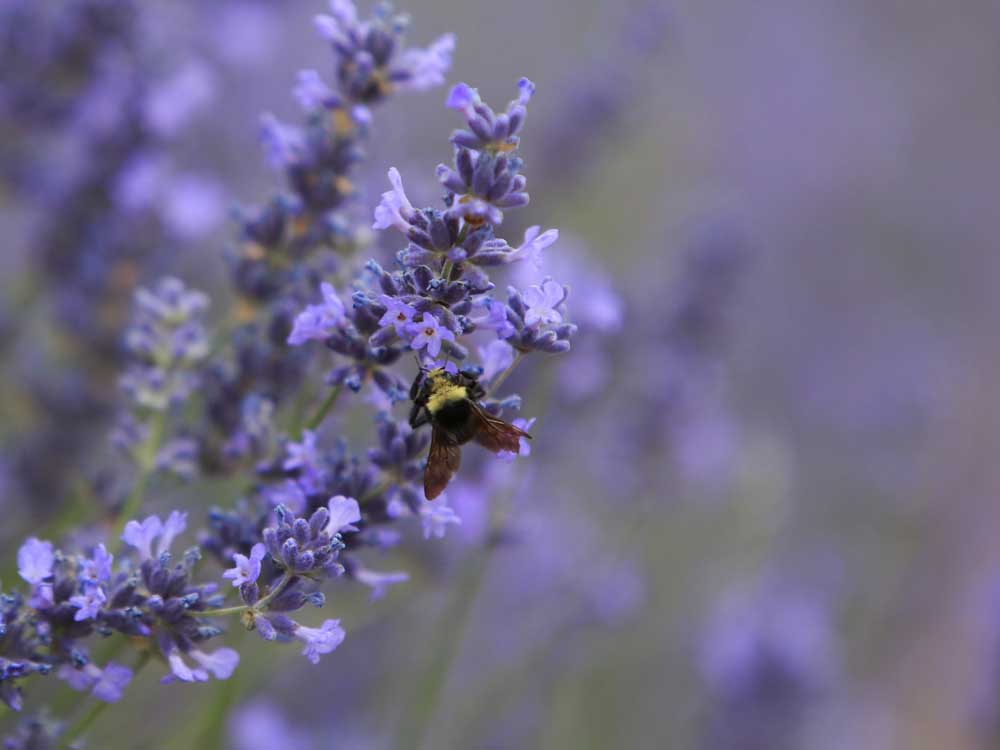Garden corner: Landscaping with deer-resistant flowers and plants
Published 2:00 am Sunday, May 2, 2021

- A bee clings to a lavender branch in a field at Cascade Lavender in Madras. Local lavender is a good choice for a deer-resistant landscape plant.
There are many old and well-known sayings regarding time and place. Some biblical, some humorous and always good reminders for the progression of our days. With that in mind, it’s time for the annual “What to do? A deer ate my plants!”
And this is the place where it happens.
The deer that happily prance through our landscape are the mule deer, whitish rump, black-tipped tail and huge ears. May to June is when you will see deer mamas with possibly two fawns. According to a Cornell University Extension publication, a lactating doe requires 4,500 calories daily. Another source states the daily needed food is 7 to 10 pounds. When you think of those calories as buds, leaves, tender shoots and flower parts, that adds up to lots of foraging.
I am convinced our drought conditions of over a year have caused the deer to eat anything and everything far beyond what they have browsed in the past. The “faithful five” have never touched my lavender, partridge feather, tanacetum densum or wooly thyme, until early spring of 2020. Some may say it might have been another critter. No, I watched them enjoy their meal, so I know who did the deed. You can identify deer damage by the show of jagged or torn edges on the stems left behind. It will not be a neat cut by any means. These are strong landscaping plants, so I know they will recover but won’t be as lush as two years ago.
Plants that thrive in public plantings are good hints as to plants that deer may lightly browse or hopefully pass up entirely. Pay attention especially to the area around the Old Mill District. We are fortunate that our local nurseries are knowledgeable and stock plant materials that are deer resistant.
Fuzzy-leafed plants are difficult for deer to swallow — think of dusty miller and how often it is used in public plantings. Lamb’s-ear, the artemisia family, fern leaf yarrow, liatris and beds of iris are popular. You will also note the absence (generally) of large plantings of hosta. I tried, but it was like a three-month Thanksgiving dinner. I finally gave up and dug them out last summer.
Deer tend to shy away from plants with strong odors. Pungent herbs that have a lemony, minty, sagey taste make good choices. Chives, garlic, the alliums are often intermingled with annuals.
We want to be good gardeners by fertilizing our plants in the spring to give them a good start. We may be a little too heavy-handed and end up being part of the problem by encouraging the lush green, tender growth the deer are waiting for. Wouldn’t it be better to start building the fertility of the soil naturally instead of relying on chemicals being applied once a month?
Time flies and before you know it, it’s July and the time the deer are most interested in the veggie starts you just planted.
This means we need to go to the extreme measure of “exclusion.” Exclusion doesn’t mean just a wooden or 6-foot -high wire fence. A deer won’t go over a barrier if they can’t see a clear landing spot on the other side. If you value your food crop, create a hoop planting area. The hoops can be PVC pipe or bended metal covered with bird netting or row cover.
Deer are creatures of habit. They develop a habit of movement, using the same path for an approach direction and a second path for a departing direction. You can break that traffic pattern by using a heavy strength monofilament fishing line, stretched across the approach starting about 18 inches above ground level and tied off either to a tree or pole. I used that technique to fence off a corn patch one year. Three outstanding books are: “Creating a Deer & Rabbit Proof Garden,” by Peter Derano; “50 Beautiful Deer-Resistant Plants,” by Alan L. Detrick and “Deer-Resistant Design,” by Karen Chapman.





